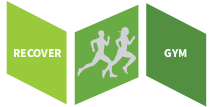The cervical vertebrates is the most moveable vertebrae in the spine. That means they have a lot more loose joints, less stability in the form of ligaments, bone structure and discs. It’s of course very beneficial for our heads to be able to move around, but that makes the neck very dependable on the musculature.
Typically the neck muscles are considered weak, because they usually are used very static and crooked. For example the position most people read texts from, the way you sit on a sofa with an iPad, etc. If the muscles can’t keep the head and neck stable, they become overexerted. This is how the classic neck issues occur.
It could also be that the neck has great strength, but a quick jerk whereby the muscles don’t tense up against it, ending in an injury in either the muscles, joints, ligaments or even the discs. This is what is known as whiplash associated disorder, which can occur from various reasons.

Find your injury in the list below:
Neck pain (Cervicalgi)
- Sudden pain in the neck region.
- Pain after sudden or excessive movements of the neck.
- The pain is aggravated by movements of the head and neck.
- Increased tension of the muscles, which also exhibit pressure soreness (sore to touch).
- Possible misalignment of the head (mal-positioning).
- Reduced movement in the neck.
Upper crossed syndrome (Chest-Neck-Shoulder imbalance)
- Bursae problems in the shoulder.
- Neck pain.
- Headache.
- Radiating symptoms in the arms etc.
- Impingement syndrome in the shoulder.
Thoracic Outlet Syndrome / TOS (chest/neck nerve impingement)
- The top exit is called the scalene gate, as it consists of a space between the scalar muscles which due to a hypertonic state are tight and stressed. The tightness of these muscles results in a compression of the nerve which results in discomfort and pain.
- The middle gate, the space between the first rib and the clavicle (costo-clavicular gate). If the fist rib is held in an upward dysfunction, it results in compression of the nerve which causes discomfort and pain.
- The lower gate made up of the space between the second and fourth rib and the muscle pectoralis minor (costo-pectoral proten). A hypertonic and thus tight and stressed muscle pectoral minor compresses the nerve towards the rib structure which thusly results in discomfort and pain.
Herniated cervical disc / Prolapsed disc in the neck
- Local pain at the site of the prolapse and possible radiating pain into one leg exacerbated by exertion.
- Prickling sensations the area of nerve intervention (dermatome).
- Svaghed i armen.
- Reflexes may be altered.
- Functional failure due to direct pressure on the nerves.
Repetitive strain injury (RSI) / Myositis
- Sore neck, shoulders, arms and wrists.
- Træthed i nakke, skuldre og arm.
- Pain in the neck, shoulders, arm, elbow, wrist and headache.
- Increased pain at continued use.
- Relief with rest.

Social Medier